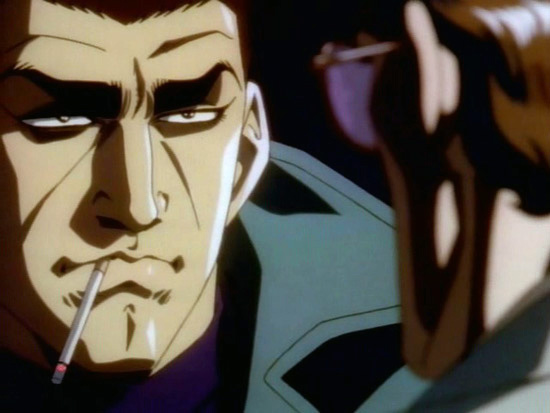
Don’t get me wrong: I love the Golgo 13 television series. The episodes are quite faithful adaptations of their source material. But in a sense, they just might be a little TOO faithful. That source material consists of Japanese comic books created by an assembly line of uncredited and virtually-anonymous artists serving as cogs in the Saito Productions machine whose purpose is to guarantee that a new installment comes out every week without fail. Fail they do not, but the tradeoff for this is that the panels, layouts, and transitions become as ruthlessly cold and efficiently workmanlike as the series’ main character. You won’t be bombarded with splash pages or experimental layouts in the Golgo 13 manga, and so the TV episodes follow suit. In addition, the TV show isn’t exactly high budget. It gets the job done, but there isn’t the necessary surplus of money to properly depict the breast groping and fondling techniques of the world’s greatest assassin and his targets, and so the television installments of Golgo 13 limit this largely to still frames of the non-pastel variety. There’s a style to it, but it’s a subtle sort of no-nonsense minimalism.
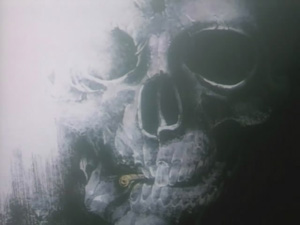 This approach is a stark departure from the Golgo 13 anime of the past. The recently deceased director Osamu Dezaki and sexagenarian character designer/animation director Akio Sugino oozed style to the point where I suspect the actual blood was removed from their bodies long ago and replaced with pastels, which in turn were used to paint the trademark still-frame “postcard memories” of their productions. (This approach was then carried over to Raiden in Metal Gear Solid.) Practicalities of hemoglobin-infused paint issues aside, Dezaki and Sugino’s 1983 theatrical film Golgo 13: The Professional boasts some of the most stylish and “out there” cinematography anime has ever seen. Everyone talks about the CG helicopter, but let that not overshadow the pink hyperspace car chase!
This approach is a stark departure from the Golgo 13 anime of the past. The recently deceased director Osamu Dezaki and sexagenarian character designer/animation director Akio Sugino oozed style to the point where I suspect the actual blood was removed from their bodies long ago and replaced with pastels, which in turn were used to paint the trademark still-frame “postcard memories” of their productions. (This approach was then carried over to Raiden in Metal Gear Solid.) Practicalities of hemoglobin-infused paint issues aside, Dezaki and Sugino’s 1983 theatrical film Golgo 13: The Professional boasts some of the most stylish and “out there” cinematography anime has ever seen. Everyone talks about the CG helicopter, but let that not overshadow the pink hyperspace car chase!
In the wake of that film’s success, no doubt due to everyone being floored at the part where the informant’s dead body just starts spinning faster and faster in the swivel chair as the cuckoo clock chimes, a Golgo 13 TV series was proposed. Alas, nothing ever came out of it because even Japan couldn’t permit there to be a TV series like The Professional in content. Who’d have guessed that TV sponsors would get skittish at the thought of making a show similar in tone to a film where an informant—a different one from the chair spinning guy—pleads that he’s being coerced to act because the bad guys have taken his wife and child, so the hero’s response is to shoot him dead without a moment’s hesitation anyway, with the implication being that these unseen innocents will be killed as a result?
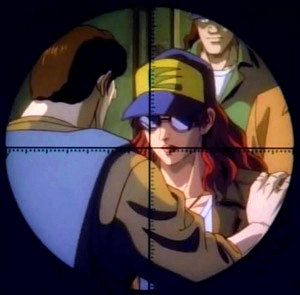 But enough about that movie, which isn’t available on Blu-Ray in the US and is out of print on DVD. A Golgo 13 animated TV series wasn’t viable in the 80s, and making another movie was seen as too risky a proposition due to the added budget overhead. What’s more, the direct-to-video “OVA” format was still in its infancy and thus unlikely to reach Golgo’s target audience of much older salarymen. Regardless, producer Mataichi Yamamoto was dead set on there being a follow-up, but there was no way he wanted it made without Dezaki and Sugino on board. But they’d moved on to other projects, such as the stellar 1990s anime adaptations of Brother Dear Brother and, more famously, Black Jack. Like Golgo, those Tezuka Productions Black Jack OVAs and movie are drastically different from the manga that inspired them too; reflecting back on them, Osamu Dezaki noted that “I made Black Jack based on Golgo 13, in some ways.” It would be 15 years before Yamamoto could, with the assistance of Tezuka Productions, pull the trigger (lovingly and softly… okay, I’m stopping for real this time) on a new Golgo 13 animation with Dezaki and Sugino on board, and by then OVAs had been established. Thus was born the one-hour Golgo 13: Queen Bee.
But enough about that movie, which isn’t available on Blu-Ray in the US and is out of print on DVD. A Golgo 13 animated TV series wasn’t viable in the 80s, and making another movie was seen as too risky a proposition due to the added budget overhead. What’s more, the direct-to-video “OVA” format was still in its infancy and thus unlikely to reach Golgo’s target audience of much older salarymen. Regardless, producer Mataichi Yamamoto was dead set on there being a follow-up, but there was no way he wanted it made without Dezaki and Sugino on board. But they’d moved on to other projects, such as the stellar 1990s anime adaptations of Brother Dear Brother and, more famously, Black Jack. Like Golgo, those Tezuka Productions Black Jack OVAs and movie are drastically different from the manga that inspired them too; reflecting back on them, Osamu Dezaki noted that “I made Black Jack based on Golgo 13, in some ways.” It would be 15 years before Yamamoto could, with the assistance of Tezuka Productions, pull the trigger (lovingly and softly… okay, I’m stopping for real this time) on a new Golgo 13 animation with Dezaki and Sugino on board, and by then OVAs had been established. Thus was born the one-hour Golgo 13: Queen Bee.
Look around on the Internet for reviews of Golgo 13: Queen Bee and they’ll all say variations of “it’s too short,” or “it’s forgettable compared to Dezaki/Sugino’s other work.” Well, have I got news for you: once again, everybody is wrong and I am right because this cartoon TOTALLY RULES.
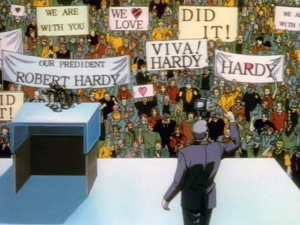
You may not remember the 2000 US Presidential election because it didn’t turn out as depicted in Eagle: The Making of an Asian-American President. (That wasn’t until the 2008 election.) But since Golgo 13 is responsible for every major sociopolitical event that has occurred in our lives such that to watch and read Golgo 13 is to know history, what REALLY happened is that before Golgo 13 shot the last batch of winning votes for Al Gore, thus making George W. Bush the winner, Gore had to first become the Democratic Presidential nominee. THAT didn’t happen until after the previous Democratic primary frontrunners, Robert Hardy and his running mate Thomas Waltham, were no longer in the race.
Wait, you don’t remember those candidates or that unforgettable moment during the Democratic National Convention? Luckily for you, this cartoon is a documentary of these real-life events! Oh sure, you might raise an eyebrow wondering since when did the Democrats in the year 2000 have what is referred to as “the white vote” locked up no problem, but that’s just because you don’t know about Robert Hardy. Hardy ran on an anti-drug platform that was as strong as its English-language slogan was grammatically awkward, though just between you, me, and Golgo 13 he was secretly a junkie. In light of this, maybe “Robert” wasn’t his real name after all; perhaps it was “Jeff” or possibly “Matt”! Regardless, his running mate Waltham was so concerned about repeated death threats signed “Queen Bee” that he hired Duke Togo—aka The Man with the Custom M-16, aka the Perfect Machine of Snipe, aka my spiritual dad Golgo 13—to assassinate this “Queen Bee” before she could kill the man who would be President.
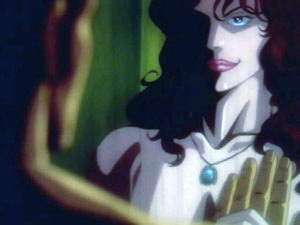
It didn’t take him long to track down Queen Bee, who is the bodacious redhead in these poster images if you couldn’t guess, but this assignment was a bit more complicated than usual. I should note that Queen Bee, whose true name and backstory are revealed as the story unfolds, is never actually topless save for bullet bandoliers at any point in this cartoon, despite what the poster suggests. That would just be crass! No, she’s just plain ol’ topless. A LOT.
The man codenamed Golgo 13 may be the one with the reputation for having all the sex and doing all the killing, but the woman codenamed Queen Bee upstages him handily this go-round. I think there is something like eight separate sex scenes in Queen Bee, and the anime is only about an hour long with credits! That translates to naked ladies roughly every 7 minutes or so. The code name “Queen Bee” is most apropos, for at the rate she’s going I’m willing to bet that entire village of children who all call her “Mama” really ARE all her kids from a myriad of dead drone fathers. One may wonder just how she manages to maintain her figure after popping out so many buns from the oven, but I imagine copious quantities of cocaine as well as routine killing of police officers, soldiers, and informants keeps the metabolism at peak levels. If she’s pregnant that often, when does she have time to lead her paramilitary guerilla unit into battle? I guess she has to do so while pregnant. (This approach was ALSO carried over into Metal Gear Solid.) Dezaki notes that Queen Bee’s breasts are “a little too big” given her occupation and fitness level, but I’ll give the character designs of Akio Sugino and Hiroshi Uchida the benefit of the doubt by assuming she’s on a perpetual lactation cycle.

The most perplexing aspect about Golgo 13 in general is not the fact that everybody knows who he is, what he looks like, and what he does for a living yet still can’t or won’t stop him. Nor is it that Duke Togo can make all these impossible shots and give women the orgasms of their lives simply by lying motionless and not making a sound. No, the craziest thing is the fact that everyone DOES know who Duke is and how much more awesome he is than everyone else on both the battlefield and in the sack, yet they underestimate him ANYWAY! For reasons unfathomable beyond “they are too stupid to live,” the powers that be decide that hiring Golgo 13—based on the fact that he has NEVER FAILED EVER—just isn’t enough to guarantee success, so they decide to implement a backup option.
I suppose everyone needs an adversary and one thing’s for sure, Dezaki’s Golgo 13 villains are a cut above mere gangsters and rival sharpshooters. In the 1983 film, Dezaki and Sugino came up with some highly memorable adversaries: the blade wielder Snake as well as the tandem duo of Silver and Gold, who just may have a record for being the most hyped up nemeses of Golgo 13 ever. With Queen Bee being only an hour long, they simply decided to combine all three of those into one guy: Dr. Kiriko from Black Jack! No seriously, they literally reused the same character design. Osamu Tezuka’s star system lives on by way of Benning, who in a cast consisting entirely of crazy people manages to be the craziest.
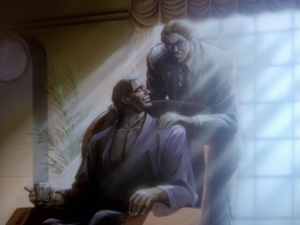
But Golgo 13 doesn’t NEED help. In fact, so dedicated is he to his work of assassinating people that if someone else tries to kill his assigned target, he will save the target from being killed just so HE can be the one to get the kill. As the TV series and manga repeatedly demonstrate, it doesn’t even matter if the target had previously saved him from certain death or is possibly carrying his child. (Actually, that’s probably incentive for him to take out a target since he does not tolerate impostors.) That’s the difference between Golgo 13 and the rest of us, or even other assassin characters: nothing will stop him. When Golgo 13 gets stabbed in the gut with a Crocodile Dundee-approved knife while waist deep in muddy water, he’s still perfectly capable of laying pipe in the jungle. There is still enough blood left in his body to divert. Where does this blood come from? Golgo 13 does not, as far as I can tell, eat food except to keep up appearances. I can only assume that he actually feeds off of the spiritual essences of those he kills and has sex with. It’s a double meal if he has sex and then kills them, which happens more often than not. In other words, Golgo 13 remains the best character ever created. In light of this, I suspect that the original draft of Laura Mulvey’s feminist film theory essay “Visual Pleasure and Narrative Cinema” from the 1970s, which popularized the concept of “male gaze,” was in fact just a still image of Golgo 13 staring.
Despite all the violence and sex, Golgo 13 is not something that should require an ID check at a convention or club showing. It’s solidly “R”-rated. Perhaps that would be a different story had the Democratic ticket of Waltham and Hardy been shown to have a homosexual relationship as originally planned (further support for my Matt/Jeff hypothesis?), but against Dezaki’s will the producers got cold feet and excised the scene of two middle-aged guys kissing complete with that yaoi anime saliva line drip. It’s not that they were opposed to people being gay—they asked Dezaki to do it in the first place—but upon seeing the finished product, they realized if that scene stayed in it’d become the only thing anyone would ever remember from this anime. If you must know, they also cut out the scene of a child’s… blood… spilling for similar reasons. Dezaki was fine with that one.
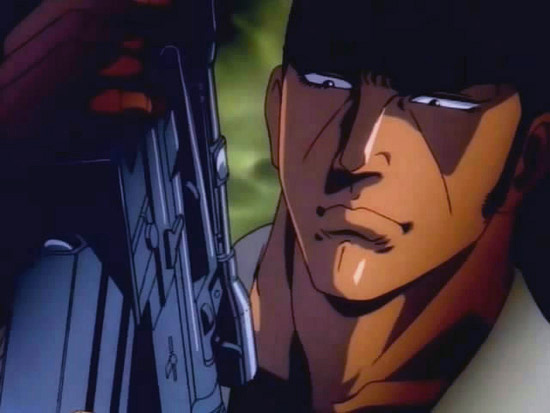
For all its majesty and glory, Golgo 13: Queen Bee was not nearly the financial success that Golgo 13: The Professional was, either in Japan or in the United States. OVAs may have been a mature medium and distribution method, but generally speaking they were almost exclusively the “otaku” medium of choice. General audiences just aren’t as inclined to go see something when it isn’t a theatrical release or television broadcast. I for one cannot think of too many other OVAs that were intended primarily to be viewed by old businessmen, and I suppose Queen Bee demonstrates why. Complicating matters further is the fact that the US DVD was released by Urban Vision, and like everything else that company released, Queen Bee is several years out of print. You shouldn’t have too hard a time tracking it down for around $10 online, though. It’s a competently put-together package, featuring 5.1 audio for not just the English dub but the Japanese audio as well. The dub was recorded in California and features talent that are usually a notch or so above the pay grade of a typical anime dub. For you Gears of War fans, the actors for both Marcus Fenix and Dominic Santiago (John DiMaggio and Carlos Ferro, respectively) are present as the leads, and…say, is that Dwight Schultz from The A-Team as Thomas Hardy?! Much of the spoken dialogue goes to Queen Bee as voiced by Denise Poirier, who in the mid-to-late-90s seemed to have a lock on voicing breathy cartoon ladies who didn’t wear a whole lot. Why, not only was she Aeon Flux once that character started talking, 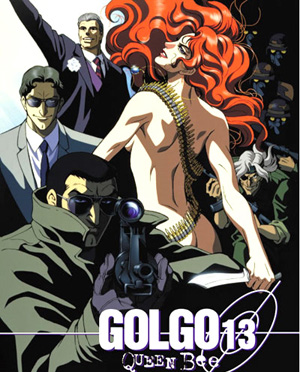 she was Angela in Spawn, too! Or Thhhhhhpawwwn., as Todd MacFarlane pronounced it. It even comes with a Japanese commentary track featuring Osamu Dezaki and Mataichi Yamamoto, which for the curious is where all of the quotations from them appearing in this article originate.
she was Angela in Spawn, too! Or Thhhhhhpawwwn., as Todd MacFarlane pronounced it. It even comes with a Japanese commentary track featuring Osamu Dezaki and Mataichi Yamamoto, which for the curious is where all of the quotations from them appearing in this article originate.
Prior to his death, director Osamu Dezaki had stated how he wanted to make much, much more Golgo 13 anime than just the movie and this OVA, but unfortunately that is no longer a possibility. That he ended up not directing the Golgo 13 TV series in favor of the anime adaptation of the notoriously terrible Milla Jovovich film Ultraviolet is unfortunate. Still, the two installments of Golgo 13 that he managed to make are so stylish and so unique that it might just be impossible to surpass them. Then again, when it comes to Golgo 13 there is no such thing as “impossible.”


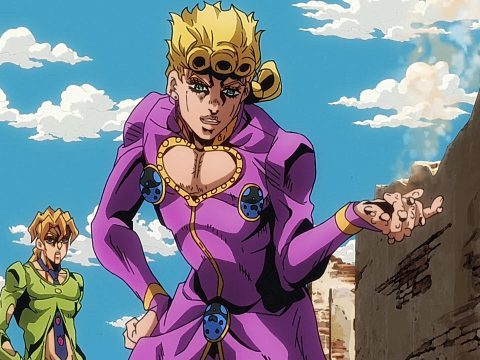
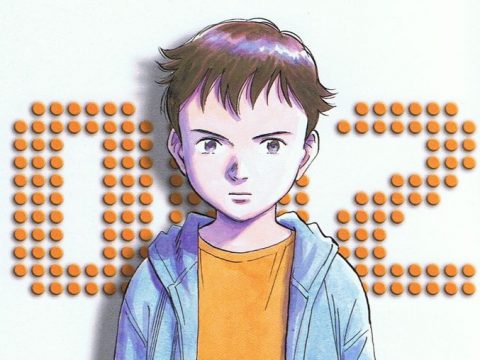
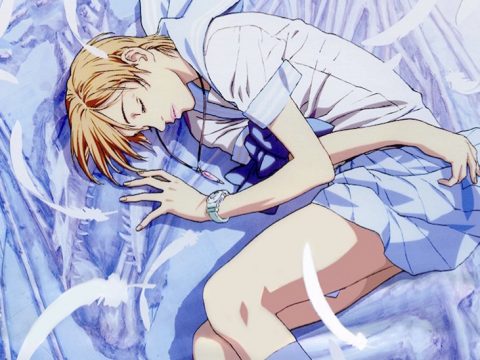
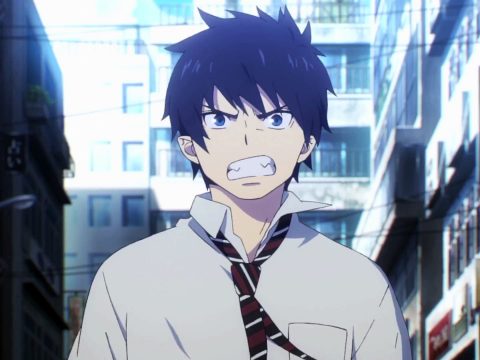
![[Review] Ghost in the Shell Deluxe Edition Manga [Review] Ghost in the Shell Deluxe Edition Manga](https://otakuusamagazine.com/wp-content/uploads/2017/08/gitsdeluxeheader-480x360.jpg)
